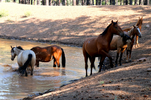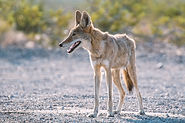Mountain Lion
Puma concolor

Look for tracks in soft dirt near water and scat along trails.
The mountain lion, also known as a cougar or puma, is a large, solitary cat and an apex predator in Arizona’s forests, mountains, and desert foothills. Elusive and mostly nocturnal, mountain lions are rarely seen by people, but their presence is often indicated by tracks, scat, and the remains of deer or other prey. They are highly adaptable hunters, relying on stealth and powerful leaps to catch deer, elk, and smaller mammals. Adults typically range from 80 to 150 pounds, with tawny coats that help them blend into rocky terrain and dense vegetation. As top predators, mountain lions play a crucial role in maintaining the balance of ecosystems by controlling ungulate populations and influencing the behavior of other wildlife. Despite their rarity, their presence is a testament to the wild and untamed nature of Arizona’s landscapes.
Mammal

Identification & Behavior
Key Features: Long tail, tan coat, muscular body
Size: 70–150 lbs
Behavior: Stalk-and-ambush predator, solitary, territorial
Diet: Carnivore — deer, elk, small mammals
Activity Pattern: Crepuscular/Nocturnal
Habitat & Distribution
Found statewide in Arizona, primarily in forested mountains, rugged canyons, and desert highlands. Prefers remote areas with rocky terrain, cliffs, and dense vegetation. Frequently observed along the Mogollon Rim, Kaibab Plateau, White Mountains, and Santa Catalina Mountains. Present in Kaibab, Coconino, Prescott, Apache-Sitgreaves, and Tonto National Forests.
Elevation Range: 2,000–10,000 ft
Seasonal Presence: Year-round
Risks & Management
Never run if encountered; back away slowly.









































